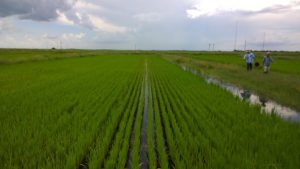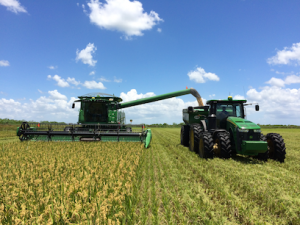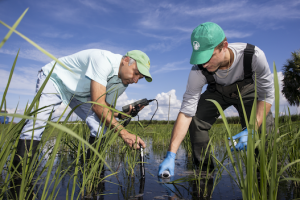We set aside September to celebrate National Rice Month. While it is a minor crop in Florida, it still plays an important role. The vast majority of rice grown is in the Everglades Agricultural Area (EAA). Producers grow it in rotation with sugar cane, which helps with improving soil quality in those fields.

“Cultivating rice in Florida is unique because the crop generally does not need fertilizer. This is because the plants draw on excess phosphorus, nitrogen, and potassium in the soil from the previous sugarcane or vegetable crop,” said Dr. Jehangir Bhadha, assistant professor of soil, water, and nutrient management in the UF/IFAS Soil and Water Sciences Department.
Bhadha is one of the authors of Rice Production in Florida: A Handbook from UF/IFAS Extension. With production steadily rising in the state, the handbook is a useful resource for Florida producers, researchers, and the general public, which gets updated regularly.
“The handbook includes such topics as rice variety trials, water management, nutrients, pest and disease management, and information related to post-harvest processing,” Bhadha explained.
Rice Products
Most consumers know table rice as the main product, but they are not familiar with the many other markets for it. According to UF/IFAS researchers, broken rice is valued at 50-60 percent of what whole kernel rice demands. Still, there are many uses for that less than perfect piece.

Being gluten-free, rice brokens, as the pieces are called, can be ground into rice flour. Increased demand for this flour is due, in large part, to the number of people diagnosed with Celiac disease. Baby food also includes rice flour as an ingredient. Biodegradable and edible films and edible cutlery also use flour and rice starch.
“The variety of uses range from pet food to brewing applications,” Bhadha said. “Rice bran is also in cattle feed, poultry litter, a soil amendment and bedding material for plants, and a medium to clean up major oil spills.”
Rice Research
UF/IFAS researchers have been studying rice for decades. Research has shown that the production of flooded rice provides several benefits to the agroecosystem. Flooding fields greatly reduces the negative impacts from issues related to soil subsidence, improves soil quality, and reduces nutrient depletion and insect pests. This, in turn, enhances the subsequent sugar cane crop and maximizes the longevity of the soil by reducing soil loss due to oxidation. In addition, incorporating it as a rotation crop in the EAA during the summer months also provides local employment.

As for new research, Bhadha and his IFAS colleagues are working on topics related to utilizing flooded rice as a treatment technology to reduce nutrient loading; identifying varieties that require fewer nutrient inputs, yet provide high yields; and exploring the potential of growing rice during the winter months instead of rendering fields fallow.
For more information on the topic, contact Dr. Bhadha at jango@ufl.edu and connect with him and his research on Twitter @UFSustainableAg.
 0
0
